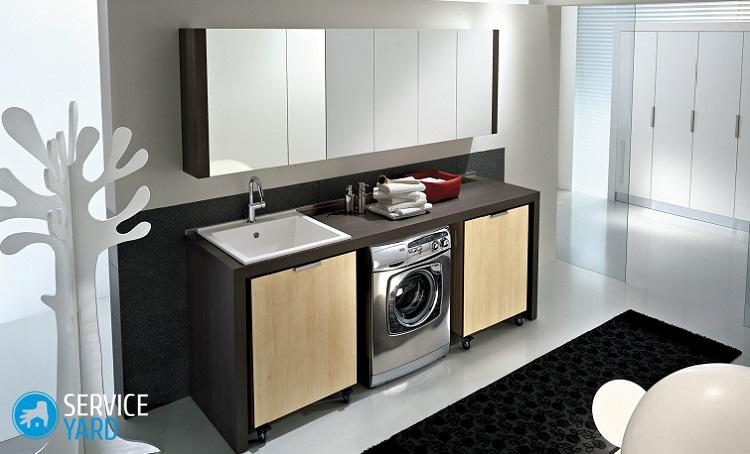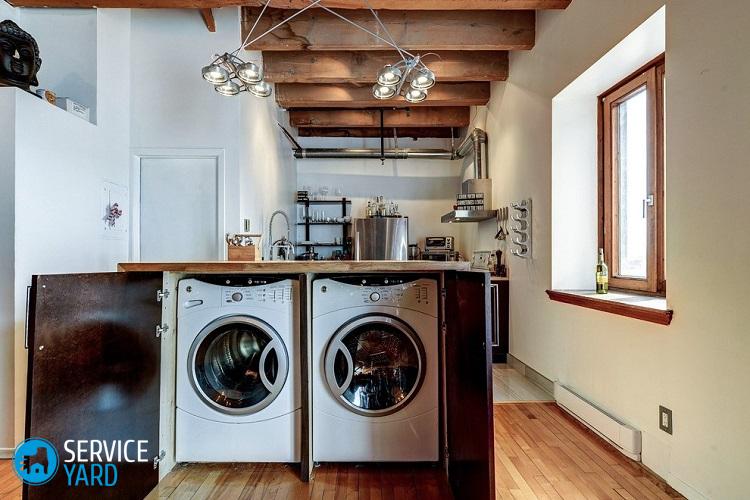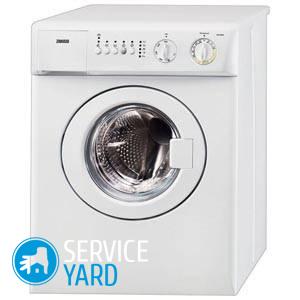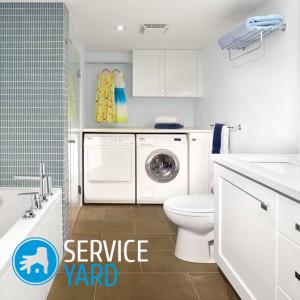DIY washing machine installation

Self-assembly of the washing machine is available to any home master if he has at his disposal a regular set of wrenches, basic knowledge of electrical engineering and a pair of hands growing from where you need it. If any of the above components is missing, installing a washing machine with your own hands will not be the best choice, it is better to invite a master. Well, if you have the time and desire to do something in the house yourself - for work!
to contents ↑Place of installation - choose a room
Before you connect the washing machine yourself, you need to decide where to place this unit. For example, if it is a bathroom, then you need to be very careful with the dimensions of the unit. As a rule, with space in the bathrooms is not crowded. If you want to put SMA in the kitchen, then the best option is the built-in option. Let's consider them in more detail.

Bathroom
Installation and Connection washing machine in the bathroom - design this type is most common. If there is very little space, pay attention to the small-sized models that are placed under the sink. It is important to choose the right height of the equipment.

Kitchen
In this case, the washing unit can be integrated into the kitchen set or put separately from the set. The advantage of the kitchen is that the ventilation on it is better.

Hallway
Oddly enough, but sometimes the washing machine is installed in the hallway or in the pantry. This is quite possible if the space in the bathroom or kitchen is more valuable to you than the space in the hallway.
to contents ↑Important! Depending on the type of flooring, there may be certain nuances in the installation process. You may find the instructions and detailed practical recommendations useful in order toinstall the washing machine on a wooden floor.
General layout rules
Regardless of where exactly you have chosen a place for a washer, it is important that it meets the following requirements:
- The closer the communications are, the better. Sewerage and plumbing should be located as close as possible to the washer. Otherwise, you will have to lay communications additionally. The same goes for power outlets.
- Smooth and stable floor. It is necessary that the washer is standing exactly on the floor, and the floor does not sway and does not bend under it. The best options are tile or concrete. Additionally, you can use specialanti-vibration stands for the washing machine.

How to connect a do-it-yourself washing machine? Training
Before installing the unit, you must perform several preliminary steps:
- Read the instructions for the washer, as it contains a detailed description of not only the device, but also the installation of the device.
- Unpack the washer, remove all packaging. It is clear that you know about this, but, as they say, just in case.
- Remove the transport bolts.
- Complete with a washing machine are special plugs made of plastic. Insert them into the holes that remain after unscrewing the transport bolts.
- Move the device closer to the installation site, but not close to the wall, as you will need free access to the rear of the machine.

The order of connection to the sewer
This is the first stage of installation. The best option is to install the siphon and connect through it.
Important! If this cannot be done for any reason, hang the hose directly on the bath. Waste water will drain into the tank, and from there - into the sewer. Of course, the last option can not be called practical and aesthetic, but in extreme cases it will do.

Operation procedure with standard connection:
- Look at the instructions for requirements on the height of the bend of the hose to drain the water. If the machine is equipped with a check valve, then there is no need for such a requirement. If there is no check valve, then the minimum connection height for the drain hose from the floor is 0.5 m.
- Connect the hose to the siphon using a hose clamp.
- When directly connecting the hose to the sewer, you must use a rubber cuff.
However, no matter what connection method you use, be sure to check that there are no leaks. This is the highlight.
Important! Regardless of which model of SM you prefer and where you decide to install it, you will have to decide on the purchase of detergents for its use. Read articles on this topic on our website:

DIY connection of the washing machine to the water supply
To connect the equipment to the water supply, you will need a special inlet hose for the washers. A hose can be supplied with a washing machine. If it is not, then you can purchase it separately.
In order for the washing machine to take water, you need to connect it to the water supply. To do this, you need a hose for washing machines. It can go both complete with a washing machine, and it can be bought separately:
- Screw the bent end of the hose to the washer.
- Connect the other end to the water supply.
- Before the flexible hose going to the cold water tap, install a tee and screw both hoses into it - for washing and for cold water
Important! It is convenient to pre-make a branch in the pipe with a crane for washing, or to make a separate outlet specifically for the machine. Do not use extra keys when tightening plastic nuts. Such nuts are designed for manual tightening; they can be damaged with a wrench.

Alignment
This stage also cannot be neglected if you do not want the machine to jump on the floor during operation. In almost all models, the legs are adjustable, so even if the floor is not quite even, you should not worry. The correct installation, and, accordingly, the untwisting-twisting of the legs, check the building level.
Have you installed the machine? Now shake it slightly from side to side. If the machine is still unstable, adjust the legs again, remembering to use the building level.

Power connection
There is nothing new to invent here. Just plug the device into a power outlet and it will work. However, there are specific points when installing a do-it-yourself washing machine:
- It is advisable to ground the wash.
- If the house does not have grounding, then use an RCD. For bathrooms, the cutoff current is 10 mA, for an apartment - 30 mA.
- If you installed the appliance in a bathroom, use it for safety reasons. moisture proof outlet.
to contents ↑Important! Finished with the installation? It's time to deal with the settings of the modes. A detailed decryption will help you with this.icons on the washing machine.
Stock footage
Now is the time to start a control wash without laundry. After that, the unit will be completely ready for operation. Congratulations, the independent connection of the washing machine was successful!










